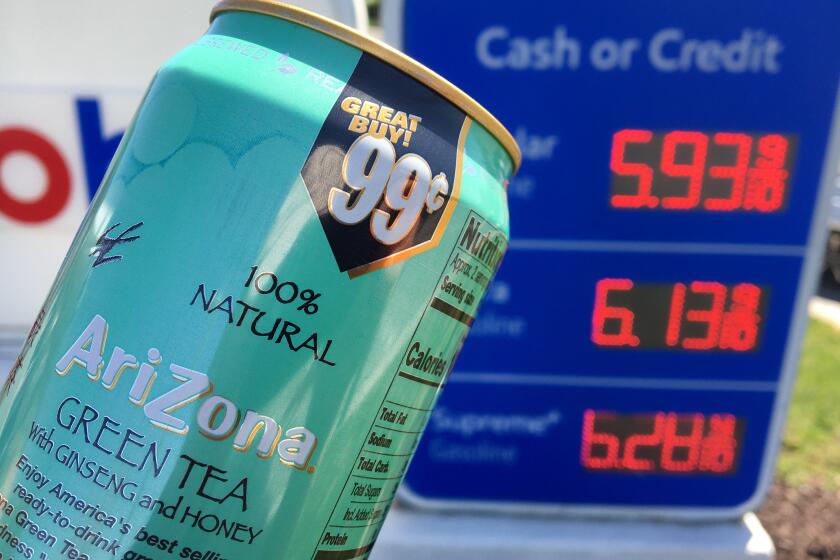Nasdaq has its worst month since 2008 as tech stocks sink

- Share via
The Dow Jones industrial average slumped more than 900 points Friday as another sharp sell-off led by technology stocks added to Wall Street’s losses in April, leaving the S&P 500 with its biggest monthly skid since the start of the pandemic.
A sharp drop in Amazon weighed on the market after the internet retail giant posted its first loss since 2015. The decline knocked more than $200 billion off Amazon’s market value.
The Standard & Poor’s 500 fell 3.6% and finished April with an 8.8% loss, its worst monthly slide since March 2020. The Dow slumped 2.8%.
The Nasdaq composite index, heavily weighted with technology stocks, bore the brunt of the damage this month, ending April with a 13.3% loss, its biggest monthly decline since the 2008 financial crisis.
Major indexes shifted between slumps and rallies throughout the week as the latest round of corporate earnings reports hit the market in force. Investors have been reviewing a particularly heavy batch of results from big tech companies, industrial firms and retailers.
But some disappointing results or outlooks from Apple, Google’s parent company and Amazon helped fuel the selling this week.
“When you start to hear from companies saying that perhaps demand is down, the concerns over a deeper slowdown in the economy gain momentum, and that’s where we are,” said Quincy Krosby, chief equity strategist for LPL Financial.
Traders also continue to fret about the tough medicine the Federal Reserve is using in its fight against inflation: higher interest rates. The central bank is expected to announce another round of rate hikes next week, a move that will further increase borrowing costs across the board for people buying cars, using credit cards and taking out mortgages.
The S&P 500 fell 155.57 points to 4,131.93 on Friday. The benchmark index is now down 13.3% for the year. The Dow dropped 939.18 points to 32,977.21. The Nasdaq slid 536.89 points to 12,334.64. It’s down 21.2% so far this year.
Smaller-company stocks also had a rough day. The Russell 2000 slid 53.84 points, or 2.8%, to 1,864.10.
Amazon slumped 14% after reporting a rare quarterly loss and giving investors a disappointing revenue forecast. The weak update from Amazon comes as Wall Street worries about a potential slowdown in consumer spending along with higher inflation.
Tall cans of AriZona iced tea have cost 99 cents since 1992. The family behind the company says it’s committed to that price even as the prices of aluminum and corn syrup climb higher.
Prices for food, gas and most other things have been rising as the economy recovers from the pandemic and there has been a big disconnect between higher demand and lagging supplies. Russia’s invasion of Ukraine has only added to inflation worries as it drives price increases for oil, natural gas, wheat and corn.
The Commerce Department on Friday reported that an inflation gauge closely tracked by the Federal Reserve surged 6.6% in March compared with a year ago, the highest 12-month jump in four decades and further evidence that surging prices are pressuring household budgets and the health of the economy.
The latest report on U.S. inflation follows a report from statistics agency Eurostat that shows inflation hit a record high in April of 7.5% for the 19 countries that use the euro.
Bond yields rose after the hot readings on inflation. The yield on the 10-year Treasury rose to 2.90% from 2.85%.
Persistently high inflation has prompted central banks to raise interest rates to temper the effects on businesses and consumers.
Much of the anxiety on Wall Street in April has centered on how quickly the Fed will raise its benchmark interest rate and whether an aggressive series of increases will crimp economic growth. The chair of the Fed has indicated the central bank may raise short-term interest rates by double the usual amount at upcoming meetings, starting next week. It has already raised its key overnight rate once, the first such increase since 2018, and Wall Street is expecting several big increases over the coming months.
Investors spent much of April shifting money away from big tech companies, whose stock values benefit from low interest rates, to areas considered less risky. The S&P 500’s consumer staples sector, which includes many household and personal goods makers, is on track to be the only sector in the benchmark index to make gains in April. Other safe-play sectors, such as utilities, held up better than the broader market; technology and communications stocks are among the biggest losers.
More to Read
Inside the business of entertainment
The Wide Shot brings you news, analysis and insights on everything from streaming wars to production — and what it all means for the future.
You may occasionally receive promotional content from the Los Angeles Times.











